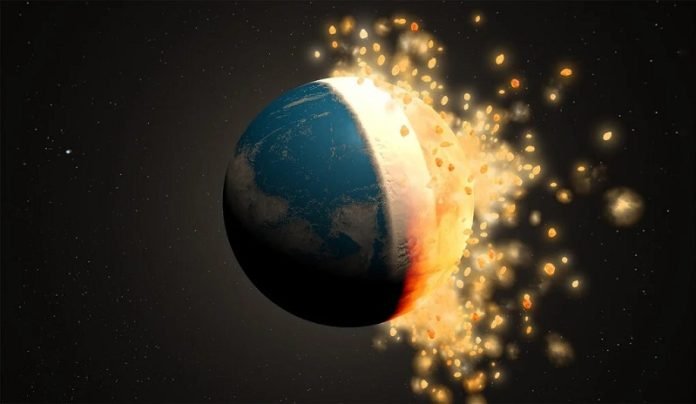
In a spectacular scientific discovery, researchers have unraveled a dazzling mystery about how gold, platinum, and other precious metals found their way into the Earth’s mantle, surprising scientists and offering new perspectives on our planet’s history.
Long ago, our Earth was quite literally under celestial bombardment! Giant objects from space, as big as our moon, collided with our young planet.
This wasn’t just a casual meeting.
The clashes were violent and chaotic, bringing with them precious gifts from the cosmos: metals like gold and platinum.
But how did these treasured elements from space get into the Earth’s mantle instead of plunging deep into its core? A team of scientists might just have hit upon a glittering theory.
Yale University’s Professor Jun Korenaga and Simone Marchi from the Southwest Research Institute (SRI) have spun a new tale that begins in the chaotic outskirts of space and trails into the cozy pockets of Earth’s mantle, far closer to our feet than anyone would have initially guessed.
Their findings, published in a well-regarded scientific journal, the Proceedings of the National Academy of Sciences, dive deep into this enchanting enigma.
Before diving into their theory, let’s understand a peculiar characteristic of gold and platinum: they are like star-struck lovers when it comes to iron, utterly attracted and drawn to it.
This attribute, scientifically termed “siderophile,” implies that when these metals entered Earth, they should have cozied up with iron in the Earth’s core. But surprisingly, they didn’t. They lingered closer to the surface, within the mantle, creating a mystery that has perplexed scientists for years.
So how did these precious metals end up where they are now? Korenaga and Marchi theorize about a thin, temporary layer in the Earth’s mantle, which partially melted while its deeper counterpart remained solid. Imagine a layer cake, where the icing is partly melty and gooey but the underneath layer stays firm.
When the precious metals descended through this “transient” layer, its unique dynamic properties acted like a trap, slowly and steadily ferrying them throughout the mantle. The researchers suggest that this process is not just a historical event but continues even today.
What makes this theory exceptionally robust and delightful is that this transient region forms typically when a large object from space smashes into early Earth.
These precious metals didn’t just make a quick drop and stop; they went on a slow, deliberate journey, influenced by a short-lived, dynamic environment that existed for a mere day but left a legacy that has persisted for billions of years.
It’s a tale that not only demystifies the location of precious metals within our planet but also sets a stage to understand the evolutionary tale of Earth and, possibly, planet formation across the vastness of the universe.
The revelation shines a light on the incredible range of timescales that have played pivotal roles in shaping our world, from a single day to several billion years, influencing Earth’s formation and evolution in multifaceted ways.
This research, supported by NASA and the National Science Foundation, serves as a spectacular testament to what can happen when scientists question the status quo and look at old puzzles with fresh eyes.
Korenaga’s and Marchi’s glittering discovery does not only satiate scientific curiosity but also spins a tale that might very well become a golden chapter in understanding the mysterious and enchanting history of our planet.
Follow us on Twitter for more articles about this topic.



